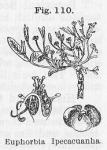 Related entries: Euphorbia Corollata.—Large Flowering Spurge
- Euphorbia Hypericifolia.—Large Spotted Spurge
- Euphorbia Pilulifera.—Pill-Bearing Spurge
- Euphorbium.—Euphorbium
- Ipecacuanha (U. S. P.)—Ipecac
Related entries: Euphorbia Corollata.—Large Flowering Spurge
- Euphorbia Hypericifolia.—Large Spotted Spurge
- Euphorbia Pilulifera.—Pill-Bearing Spurge
- Euphorbium.—Euphorbium
- Ipecacuanha (U. S. P.)—Ipecac
The bark of the root of Euphorbia Ipecacuanha, Linné (Euphorbia gracilis, Elliott).
Nat. Ord.—Euphorbiaceae.
COMMON NAMES: Wild ipecac, American ipecacuanha, Ipecac spurge, Carolina ipecac, White Secac, Spurge, etc.
Botanical Source.—This is a perennial plant, with a yellowish, irregular, fleshy root, very large in proportion to the plant it bears, running deep into the sand, sometimes extending to the depth of 6 feet. The stems from one root are numerous, suberect or procumbent, smooth, thick, succulent, regular dichotomous, jointed at the forks, forming large branches on the surface of the ground, and from 3 to 12 inches long. The leaves are inserted at the joints, opposite, 1 or 2 inches long, by ¼ or ½ an inch wide, sessile, smooth, varying from oblong and circular to linear, and, in color from green to purplish. The flowers are solitary, on long peduncles from the forks of the stem, and small. Calyx spreading, with 5 exterior obtuse segments, with 5 small, gibbous, inner segments or nectaries. The stamens are numerous, in 5 parcels, appearing at different times 2 or 3 together, with double anthers. The fertile flowers have a large, roundish, drooping, pediceled germ, crowned with 6 revolute stigmas. The capsule is 3-celled, containing 3 white, areolate-pitted seeds (L.—W.—G.).
History and Description.—This is an indigenous plant, found growing in dry, sandy soils, on Long Island, in New Jersey, and the middle and southern states, and flowering from May to August. As with the E. corollata, it yields a milky juice, which causes a pustular eruption when applied to the skin. The root is the part used in medicine. The fresh root is from 3 to 7 feet long, tuberculated, and of a yellowish color; from ½ to 1 inch in diameter, and of a very acrid taste. The dry root is light and brittle, without odor, and has a sweetish, not very disagreeable taste (E. & V.). The powdered root is of a light-brown, or light snuff-color, speckled similar to E. corollata. Water or alcohol takes up its active properties. Its incompatibles are probably the same as those of the E. corollata.
Chemical Composition.—Analysis of this plant by C. Petzelt, in 1873 (Amer. Jour. Pharm., p. 255), revealed the presence of resin, gum, glucose, starch in abundance, fixed oil, calcium sulphate, and other salts. The resin is dark in color, has at first a bitter taste, which subsequently becomes pungent and nauseating. This resin he believed to carry the active emeto-cathartic properties of the root. Small doses (½ grain) acted as a hydragogue cathartic, while larger doses (1 ½ to 2 grains) induced nausea and emesis. It is insoluble in benzin and ether, but dissolves in alcohol. The root is believed to contain a glucosid from the fact that the reaction for glucose is not apparent unless the root be first boiled with a diluted acid (Dilg, Amer. Jour. Pharm., 1876, p. 485). Benzin extracts from the root, among other substances, euphorbon (see Euphorbium).
Action, Medical Uses, and Dosage.—It very much resembles the E. corollata in its action upon the system, but is less energetic. It may be employed as a substitute for it or for ipecac. It is emetic, diaphoretic, expectorant, and epispastic; and may be used in the same doses and for the same purposes as the corollata; in dropsical affections it is preferred by some practitioners. When given in cathartic doses, say from, 3 to 10 grains, it is said to promote the menstrual discharge. As an emetic and cathartic, it has been found valuable in bilious colic, but is superseded in this disease by the Dioscorea villosa, which acts promptly and efficiently without any unpleasant symptoms. In dyspepsia, 1 or 2 grains, repeated 3 times daily, will be found useful. The dose of the powdered root is from 10 to 15 grains as a hydragogue; 1 to 3 grains as an expectorant and diaphoretic. It is occasionally used in jaundice and obstinate torpidity of the liver. It was formerly principally used by physicians as a hydragogue in dropsical affections; but, in recent years, it has been used to allay gastro-intestinal irritation and inflammatory action, as in some forms of dysentery and diarrhoea.
Specific Indications and Uses.—(Same as for E. corollata, which see).

